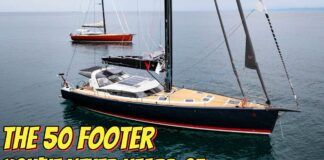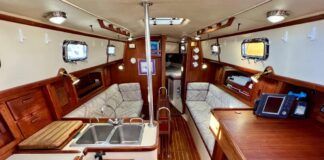I cannot eliminate the smell of diesel fuel from my boat. The previous owner had a fuel leak that soaked the wood under the fuel tank. The tank has since been fixed, but the odor remains. Any advice?
Franklin Rogers
1981 46-foot Island Trader
Florida
Our first step would be to replace the wood under the tank, if possible. Once fuel has seeped into wood grain, its near impossible to remove it completely, so replacing the affected wood would be the best option. If thats not possible, we suggest lots of cleaning, lots of ventilating, and lots of patience; it takes time for diesel odors to dissipate after a spill.
If you don’t already have them, try installing a few Nicro Day & Night Solar ventilators, which weve found do a great job of keeping a boat ventilated and fresh smelling.
You can try cleaning the fuel tanks exterior and underlying wood with a grease-cutting detergent and/or pressure washer. Also, the bilge may still be contaminated and may be causing the lingering odor, so be sure to clean it well (and regularly). Pour a bit of biodegradable detergent in the bilge, add fresh water, let it slosh around for a few days/sails, then pump it out into a bucket for shoreside disposal. Our top pick for a grease-cutting bilge cleaner in our last test (PS March 2006) was Star brites Super Orange Bilge Cleaner.
Give your cushions, linens, and any carpeted areas the sniff test too to determine whether any upholstery has absorbed the fumes. If they have, launder the offending items and shampoo any smelly carpet.
Seeking Clear Teak Oil
For the last 20 years, I have used a clear, low-viscosity teak oil made by H&L Marine Woodwork, but H&L has apparently gone out of business. Do you have a recommendation for an alternate clear (no pigment), light teak oil?
Tom White
Grove, Oklahoma
Of the products we tested in our last exterior wood finish long-term test (2007-2009), wed recommend Semco Teak Sealer (www.semcoteakproducts.com). Semco comes in several colors, but we found that once it dried, the Natural Semco looked as if it had no coating on it at all (see PS April 2008 and December 2009). With no gloss, it allows the woods natural grain to shine through without turning gray or allowing mildew to grow.
Semco, which is highly touted by boatbuilders and boat owners for use on teak decks because of its barely-there appearance, is easy to apply with a foam brush. We recommend stirring it regularly to ensure even coloring, and applying at least two back-to-back coats. Semco suggests first prepping the wood by cleaning it with a two-part cleaner. It will need to be re-applied a few times each year, but done regularly, the process should be easy. Be sure to tape off the work area well; Semco will stain gelcoat.
We have a new exterior wood finishes test underway (see PS June 2015). Stay tuned for the long-term results.
Mildew-resistant Caulk?
The seams on my boat (there are many) are original, and the white seam caulking has become mildew stained. Is there any caulk product on the market that does not mildew?
Elliott Siegel
38-foot 2008 Sabre Downeaster
Huntington, N.Y.
For the best mildew-resistant sealant, wed recommend 3Ms Marine Silicone (PS August 2010). It comes in clear and white, and while it delivers good adhesion, it is not sandable and should not be painted over. Since it wont harm plastics, it is our top choice for re-bedding plastic hatch and port lenses. For more on selecting adhesives and sealants, check out the April 14, 2015 blog post The Right Caulk for Your Boat, and maintenance resource books like Don Caseys This Old Boat (available in PSs online bookstore).




































